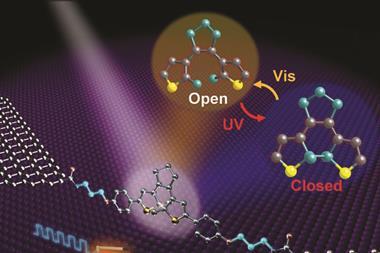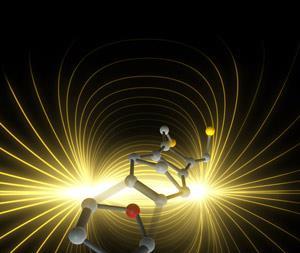Diyne is most efficient single-molecule diode ever created
‘We managed to build a diode with one single molecule bound to two electrodes,’ explains Ismael Díez-Pérez, a researcher at the University of Barcelona, Spain. Although hearing the word ‘diode’ may only bring LEDs to mind, these electronic components are much more than tiny lights. ‘A diode is an electronic component that allows the flow of current in one direction and blocks it in the opposite,’ says Díez-Pérez. ‘The principle of our device is the same as the one used in a LED, but we are still at the first step: generating the diode behaviour,’ he says.

The world’s smallest diode is a very simple molecule – 1,8-nonadiyne. Each of its two triple carbon–carbon bonds plays a key role in the functioning of the nano-diode.1 One anchors the molecule to a silicon surface using an ultraviolet light-assisted hydrosilylation reaction. The other remains free to make electrical contacts with external electrodes.
To test the diode, the team invented an experiment they called the ‘blinking test’. They used a scanning tunnelling microscope (STM) to scan the silicon surface. When the gold tip of the STM touches the free alkyne of the molecular diode it ‘closes the circuit’ and the instrument measures a sudden jump in the current – the ‘blink’. ‘We have extensively exploited this method to identify the formation of single-molecule electrical contacts,’ explains Díez-Pérez.
But the importance of this discovery goes beyond the size of the diode – its efficiency is outstanding. The efficiency of diodes can be measured using the rectification ratio (RR), the ratio between the forward and backward current flows. The RR values for the new nanodiode – around 4000 – are two orders of magnitude higher than the first single-molecule diodes developed back in 2009.2
Co-author Simone Ciampi at the University of Wollongong, Australia, says that this could ‘expand the pool of electrical circuitry by merging the richness of organic chemistry with the established knowledge and infrastructure of the silicon microchip industry’. However, he adds that real-world applications are years away. The stability and lifespan of single-molecule diodes will need to improve before they can be incorporated into electronic circuits. Nevertheless, Ciampi remains optimistic on the stability of single molecule diodes noting that ‘going from a few seconds to few months, is not without precedents’. ‘The most notable and recent example of such a leap is the stability of perovskite photovoltaic cells.’
Nongjian Tao, a molecular junctions researcher at Arizona State University in the US, says that ‘the integration of single molecule measurements with silicon is exciting; it opens the door to integrate molecular electronics with traditional semiconductors’. A few years ago, these single molecule switches were only stable at very low temperatures. Stabilising them at ambient conditions is a big step towards miniaturised circuits, he adds.
References
1 A C Aragonés et al, Nat. Commun., 2017, DOI: 10.1038/ncomms15056
2 I Díez-Pérez et al, Nat. Chem., 2009, 1, 635 (DOI: 10.1038/nchem.392).

















No comments yet